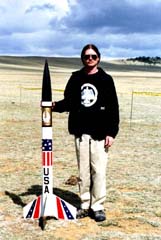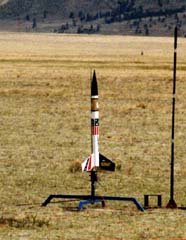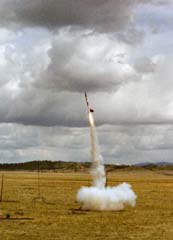Scratch Citation Patriot Original Design / Scratch Built
Scratch - Citation Patriot {Scratch}
Contributed by Dave Hanson
 Citation
Patriot Upscale Project
Citation
Patriot Upscale Project
- Scale Factor: 2.5x
- Diameter: 4"
- Length: 60"
Parts List
- PML 4"Quantum Tubing, 1-36", 1-9"
- PML tube coupler
- LOC 38mm motor mount
- 3 - 3.9"x38mm LOC centering rings
- PML 4" Nose Cone
- 1 - U-bolt
- 2 - 6/32 t-nuts
- 3 - quick-links
- 1/8" aircraft plywood for fins
- 10' tubular nylon for recovery harness
Okay, so I'm not the first to come up with this one, either. I've wanted to do an upscale Patriot for some time, and I got the initial inspiration for this project from Rich Pitzeruse's Patriot. I chose the 2.5x scale factor because it matched the 4" tubing size fairly accurately, and it would provide a model that should fly good on 38mm reloads without being too big.
I bought most of the parts at my local HobbyTown. I could've saved a buck or two getting the stuff through mail order, but the 4" Quantum Tubing is still pretty hard to find, and the prices I found online were only about a dollar less than getting them in the store. I scuffed the outside and inside surfaces of the QT with 150 grit sandpaper to facilitate adhesion of the epoxy. Due to the mix of parts from a couple different manufacturers, I had to sand the o.d. of the centering rings a bit to get them to fit in the Quantum Tube.
The body of the Patriot scales out to 45" overall, so I had to cut a 9" length of Q.T. to couple with the full-length piece. Thank goodness I know someone with power tools. It was a snap cutting the QT on Steve's chop saw, then with a little sanding the cut end was just as smooth as a factory cut. The two pieces were epoxied together with a PML coupler.
 Being the nice guy
that he is, Steve cut out the fins for me using a template that I scaled up
from the original Patriot instructions. We included tabs on the fins so I could
attach them directly to the motor mount. Cutting slots in the body tube was
achieved by routing 1/8" slots with a hand-held router. We rigged a jig to
hold the router steady, then we just slid the tube along the router until the
slots were the correct length.
Being the nice guy
that he is, Steve cut out the fins for me using a template that I scaled up
from the original Patriot instructions. We included tabs on the fins so I could
attach them directly to the motor mount. Cutting slots in the body tube was
achieved by routing 1/8" slots with a hand-held router. We rigged a jig to
hold the router steady, then we just slid the tube along the router until the
slots were the correct length.
I drilled one centering ring for the u-bolt recovery anchor and another centering ring for the t-nut motor retention. Then I epoxied the forward centering ring onto the motor mount tube. After the epoxy cured, I slid the tube into the body and marked the tube just ahead of the fin slots, then attached the middle centering ring to the motor mount. When the epoxy had cured, I slid the motor mount back into the body and epoxied it in place. I had cut the motor mount tube so that the fore centering ring butted up against the back of the coupler tube.
Then it was time to start attaching the fins. I used a little 5-minute epoxy to hold the fins in place. This held them well enough until I started applying internal epoxy fillets. After the epoxy cured, I epoxied the aft centering ring into place. Final construction consisted of attaching the nose to the nylon harness via quick-links, and epoxying a couple of 2" lengths of 1/2" copper tubing for the launch lugs. Not an overly difficult rocket to construct for anyone with average large rocket building experience.
 Finishing the Patriot
couldn't be much easier with the Quantum Tubing. One coat of Krylon primer was
followed with one coat of Rustoleum gloss white. One fin was masked and painted
gloss black, as was the nosecone. Final finishing consisted of applying the
decals. The red and blue flag and stripe decals were made from hand-cut
self-adhesive Monokote vinyl. The gold band around the upper airframe was made
from heat-shrink Monokote. The eagle emblem and Patriot emblem were decals
scaled and custom-printed by Tango Papa decals. The finished result is a very
impressive reproduction of my favorite Estes kit from my childhood.
Finishing the Patriot
couldn't be much easier with the Quantum Tubing. One coat of Krylon primer was
followed with one coat of Rustoleum gloss white. One fin was masked and painted
gloss black, as was the nosecone. Final finishing consisted of applying the
decals. The red and blue flag and stripe decals were made from hand-cut
self-adhesive Monokote vinyl. The gold band around the upper airframe was made
from heat-shrink Monokote. The eagle emblem and Patriot emblem were decals
scaled and custom-printed by Tango Papa decals. The finished result is a very
impressive reproduction of my favorite Estes kit from my childhood.
First flight of the Patriot was on May 20, 2000, on an AeroTech I211-M. This motor boosted the Patriot to a guesstimated 2,500 ft and was recovered undamaged. For recovery the Patriot uses a 60" custom made, red white and blue parachute. A very "Patriotic" final touch.
Sponsored Ads
 |
 |











